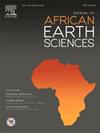利比亚东北部昔兰尼加岬角早始新世-中新世早期 Al Jabal Al Akhdar 碳酸盐岩层序地层结构与沉积演化--构造与蚀变的相互作用
IF 2.2
4区 地球科学
Q2 GEOSCIENCES, MULTIDISCIPLINARY
引用次数: 0
摘要
该研究评估了构造和侵蚀作用对早始新世-中新世早期 Al Jabal Al Akhdar 碳酸盐沉积层序结构演变的影响。通过对位于利比亚东北部 Al Jabal Al Akhdar 隆起带的五个测量断面的微地貌、沉积解释和层序地层框架进行详细分析,完成了这项评估工作。根据岩性变化、颗粒大小和成分、沉积质地和结构、化石含量、颜色和垂直堆积模式,研究区间被细分为不同的微地层。划分了六种主要沉积环境:限制性泻湖、开放性海洋泻湖、平台边缘和浅滩、平台边缘礁石、前坡和中下部斜坡。根据垂直和横向面层分布、化石含量的变化以及成岩特征,确定了四个三阶无断裂沉积序列。除较年轻的序列只包含一个迭压单元外,每个序列都由一个迭压-迭压区间组成。四个演化阶段分别为:起始阶段、生长阶段、高隆起平台阶段和次隆起阶段。构造运动和沉积物负载造成的沉降,加上海平面上升,为所研究的碳酸盐岩的沉积创造了容纳空间。反复的震旦纪海平面波动控制着内部地层的异质性和层序的发展。构造隆升导致海平面大幅后退,从而形成了碳酸盐岩序列。在晚白垩世-早始新世期间经历大隆起的中生代和古新世序列形成了碳酸盐沉积物形成的浅水正前缘地形。这项研究建立了不同循环沉积次序的碳酸盐序列地层层次,增进了我们对倒置盆地环境中碳酸盐平台的沉积和地层结构演化及沉积机制的了解。这些知识有助于预测具有重要经济意义的岩相和沉积系统的分布。本文章由计算机程序翻译,如有差异,请以英文原文为准。
Sequence stratigraphic architecture and depositional evolution of the early Eocene-early Miocene Al Jabal Al Akhdar carbonate successions, N Cyrenaica Promontory, NE Libya – Interplay of tectonics and eustasy
The interactions of tectonics and eustasy on the stratigraphic architectural evolution of the early Eocene-early Miocene Al Jabal Al Akhdar carbonate sedimentary successions were evaluated. This evaluation was achieved through detailed analyses of microfacies, depositional interpretation, and sequence stratigraphic framework of five measured sections located within the Al Jabal Al Akhdar Uplift, northeast Libya. The study interval was subdivided into distinct microfacies based on lithological changes, grain size and components, sedimentary texture and structures, fossil contents, color, and vertical stacking pattern. Six major depositional settings were delineated: restricted lagoon, open marine lagoon, platform margin and shoals, platform-margin reefs, foreslope, and middle to lower slope. Four third-order unconformity-bounded depositional sequences were identified based on vertical and lateral facies distribution, variations in fossil contents, and diagenetic features. Each sequence is composed of a transgressive-regressive interval, except for the younger sequence, which only contains a transgressive unit. Four evolutionary stages are recognized: initiation, growth, high-relief platform, and subaerial exposure. Subsidence resulting from tectonism and sediment loading, coupled with rising sea-level, created the accommodation space for the sedimentation of the studied carbonates. Repeated eustatic sea-level fluctuations controlled the internal stratigraphic heterogeneity and sequence development. Tectonic uplift caused a major sea-level retreat, resulting in the emersion of the carbonate sequences. The pre-existing Mesozoic and Paleocene sequences that underwent major uplift during the Late Cretaceous-early Eocene formed a shallow-water positive-antecedent topography for the formation of the carbonate sediments. This study establishes a carbonate sequence stratigraphic hierarchy of different cyclic sedimentation orders and improves our knowledge of sedimentary and stratigraphic architectural evolution and depositional mechanisms of carbonate platforms in an inverted basin setting. This knowledge can aid in predicting the distribution of lithofacies and depositional systems of economic importance.
求助全文
通过发布文献求助,成功后即可免费获取论文全文。
去求助
来源期刊

Journal of African Earth Sciences
地学-地球科学综合
CiteScore
4.70
自引率
4.30%
发文量
240
审稿时长
12 months
期刊介绍:
The Journal of African Earth Sciences sees itself as the prime geological journal for all aspects of the Earth Sciences about the African plate. Papers dealing with peripheral areas are welcome if they demonstrate a tight link with Africa.
The Journal publishes high quality, peer-reviewed scientific papers. It is devoted primarily to research papers but short communications relating to new developments of broad interest, reviews and book reviews will also be considered. Papers must have international appeal and should present work of more regional than local significance and dealing with well identified and justified scientific questions. Specialised technical papers, analytical or exploration reports must be avoided. Papers on applied geology should preferably be linked to such core disciplines and must be addressed to a more general geoscientific audience.
 求助内容:
求助内容: 应助结果提醒方式:
应助结果提醒方式:


